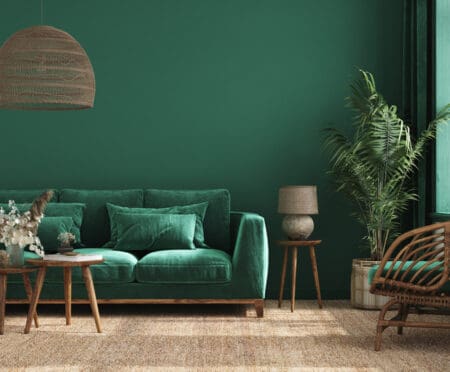The UK homeware market has shown remarkable resilience and adaptability in recent years, having faced the extended hiatus of the COVID-19 outbreak and a cost of living crisis which squeezed budgets back to the essentials. The high interest rates of 2023 also impacted homebuyers – a key target market for this sector.
Despite these challenges, the homeware sector emerged as one of the best-performing non-essential retail categories. Consumers reassessed their living spaces and prioritised spending on homeware as an affordable means of personalisation. This trend has continued, with almost 9 in 10 consumers engaging in the market in the past year; up from 8 in 10 in 2021.
Physical Stores are Becoming Social and Lifestyle Hubs
Physical retail spaces have evolved into social hubs, with 60% of consumers viewing shopping as a social activity. This trend is complemented by the rise of ‘lifestyle brands’ in homewares, where fashion-forward, trend-driven products are increasingly sought after. This is exemplified by brands like H&M and Zara expanding into homeware. Three-quarters of consumers now say well-decorated homes are crucial for relaxation; this highlights the ongoing importance of homeware in enhancing people’s well-being. Brands need to consider the social aspect of shopping, while still promoting their products to entice consumers to shop in their stores.
How Social Media is Influencing Renters
Renters remain a key consumer segment, showing the highest market engagement and likelihood to increase spending. Additionally, younger consumers, particularly those aged 16-34, are heavily influenced by social media for design inspiration, surpassing traditional sources like in-store displays.
Social media’s role in the homeware sector has grown, becoming a key point of inspiration and engagement, particularly among younger consumers. Celebrity collaborations, like Rita Ora’s bedding line and Michelle Keegan’s collaboration with Very.co.uk, exemplify this trend. It’s now common for brands to engage with their market via social media.
Reconnecting with Brick-and-Mortar Stores
There’s a noticeable appetite for returning to in-person shopping experiences for homewares, suggesting a revival of brick-and-mortar retail and opportunities for retailers to reimagine their physical store strategies.
In general, we found that multi-channel retailers edged out specialist homeware stores as a more popular option, with supermarkets dominating the homeware sector. As many are already key shopping destinations for food and clothes, homeware sales are the next logical step, and offer their customers a greater range of goods, with the convenience of a single stop, supported by a trusted brand.
Sustainability Remains A Concern
Environmental considerations are increasingly influencing consumer choices, especially among younger shoppers and urban dwellers. Retailers must address sustainability to attract environmentally-conscious consumers, as seen in initiatives like IKEA’s buyback program and the rise in charity shop’s popularity.
These concerns impact retailers at all levels, from production to delivery. Raw materials are naturally an important part of the sustainability issue, but design, packaging, manufacturing processes and delivery are all contributing factors. It’s one thing to ensure your product is made with a renewable resource, but have retailers and manufacturers also considered the impact of, for example, renewable energy in their process?
Luxury Homeware Brands Give Way to Practical Purchases
Despite the increased spending generally, practical homewares have gained precedence over decorative items, with household textiles leading the pack as consumers seek energy-efficient solutions. This shift may also be because cost-conscious consumers don’t feel able to buy purely decorative items.
Luxury homeware brands such as The White Company, Oliver Bonas, and Anthropologie may produce beautiful products for the home, but tightened budgets will be directed away from products and brands which provide luxury for luxury’s sake. However, luxury homeware brands such as Liberty of London may still benefit from the abovementioned multi-channel retail opportunities.
The popularity of kitchenware can be partly attributed to the influence of endless cooking shows. This trend has been particularly pronounced as almost half of the consumers reported newfound confidence in the kitchen. The kitchen has transformed from a purely functional space to a centre of creativity and social interaction.
Three-quarters of those surveyed echoed the sentiment that entertaining friends at home is just as enjoyable as going out. With more visitors likely to see how you cook, not just what you cook, it’s no surprise to see an uptick in kitchenware sales.
This last point is underscored by the fact that men are also increasingly purchasing homewares, especially in kitchen and dining. Unlike other demographic groups, men are less likely to trade down to low-priced homewares, indicating a willingness to invest in quality. Premium kitchen and dining homewares are thus emerging as a significant segment, appealing to male shoppers by benefiting their health and serving as a means of ego boost.
Cost-conscious consumers may want to season their kitchens with luxury homeware brands in the future. Still, for the moment, the emphasis is on effective and practical spending to enhance homes and lifestyles without compromising the budget.
Spending on Homeware Will Continue to Grow
Mintel forecasts this expenditure will continue to increase in the future. Much of this will be a result of the continuation of the trends seen in the past year, whether extended periods inside, together with the continued prioritisation of the home and redirection of expenditure. The past year has seen a broader newfound appreciation of the home, both in its role in daily life and well-being.
The past year has seen many reassess their homes, particularly communal areas, and prioritise these in future spending. While much of this was limited by the immediacy of disruption, financial pressures and a reluctance to allow tradespeople into the home in the past year, it could set the market up for a windfall of new demand, such as home extensions, kitchen and bathroom renovations and garden makeovers in the coming year and beyond.
Any increase in these big projects would have a knock-on effect on lower-ticket sectors, such as tableware, bedding and candles, as consumers look to dress and complement these new spaces.
From the impact of economic factors to the changing role of physical stores and the increasing importance of sustainability and social media, understanding these dynamics is crucial for businesses navigating this sector. As the market continues to adapt, staying informed and responsive to these trends will be key to success.
Align with the latest trends in consumer behaviour by exploring our extensive Seasonal Holiday Market Research today.
Subscribe to our newsletter, Spotlight, to get free content and insights delivered directly to your inbox.









































